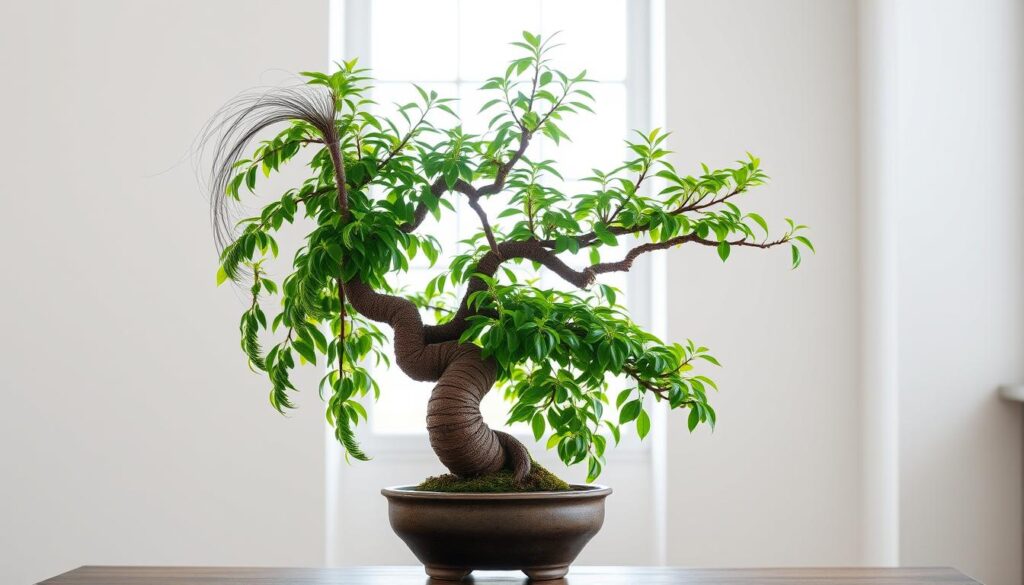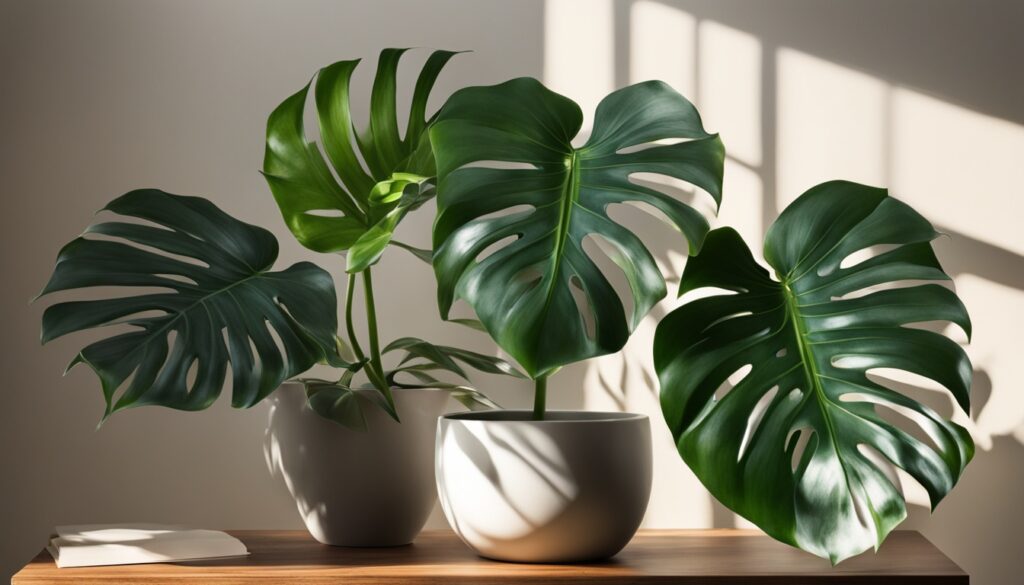Looking for a low-maintenance indoor plant that brings natural beauty to your space? The ponytail bonsai is perfect. These small palms love low light, making them great for any room.
These bonsai trees are made with great care. They have soft, flowing lines and are small. They fit well in any decor, making your space look better.
So, what makes ponytail bonsai special? They look amazing and are easy to care for. They need water and food only sometimes. This makes them perfect for people who don’t have a lot of time to care for plants.
Key Takeaways
- Ponytail bonsai trees are low-maintenance, thriving in low-light conditions
- They add a touch of natural elegance to any indoor space, from homes to offices
- These compact plants require infrequent watering and feeding, making them ideal for busy individuals
- Ponytail bonsai trees are available in a range of sizes and prices to suit any budget
- With proper care and attention, these resilient plants can bring years of joy and beauty to your surroundings
Discover the charm of ponytail bonsai and make your indoor space peaceful. Check out our selection and find the perfect tree for your home or office today!
Understanding the Ponytail Palm Bonsai Basics
The Ponytail Palm, known scientifically as Beaucarnea ‘Ponytail’, is a stunning tropical plant. It’s a perfect fit for indoor ponytail bonsai spaces. Its unique look, with “fountains of foliage,” has won over many plant lovers and fans of botanical hairdressing.
Botanical Classification and Origins
The Ponytail Palm comes from the Asparagaceae family and is from Veracruz, Mexico. It loves zones 10A to 11B and can grow up to 30 feet tall outside. But indoors, it stays around 3 to 4 feet tall.
Distinctive Features and Characteristics
Its most eye-catching feature is the fin-like leaves that flow down like a ponytail. This creative coiffure-like look is enhanced by its unique trunk. The trunk swells at the base, making it a standout piece.
Natural Habitat and Growth Patterns
In the wild, Ponytail Palms can grow up to 30 feet tall. But indoors, they stay between 12 to 20 inches tall. These slow-growing plants are usually 6 years old when sold as bonsai, showing the dedication needed to care for them indoors.
“The Ponytail Palm’s distinctive ‘ponytail’ appearance and sculptural trunk make it a captivating addition to any indoor space, offering a unique touch of botanical hairdressing to your home or office decor.”
Price Range and Investment Value
The price of ponytail bonsai starts around $30.00. This is a great deal for such a long-lasting bonsai hair styling tree. You can also find accessories like fertilizer and pruning shears to enhance your hair art experience.
Ponytail bonsai are not just beautiful; they’re also a rewarding hobby. They add natural beauty to any room. This makes them a great choice for both new and experienced bonsai lovers.
“Ponytail bonsai are the perfect fusion of nature’s artistry and human creativity, offering a captivating and long-lasting addition to any indoor environment.”
Looking to start or grow your bonsai hair styling collection? Ponytail bonsai are a great choice. They bring nature’s beauty into your home or office. With the right care, they can live for many years, offering a unique and fulfilling hobby.
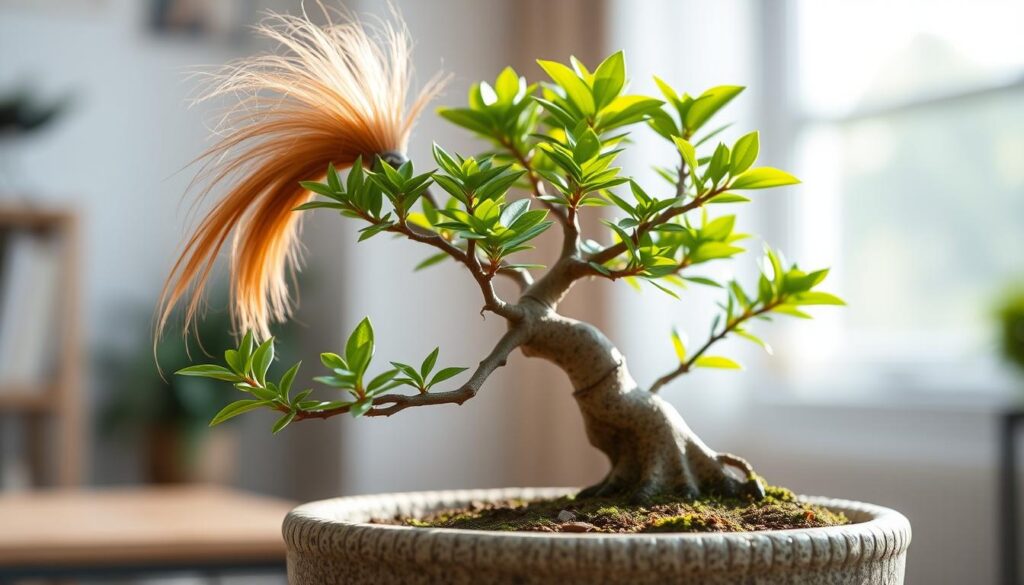
Creating the Perfect Indoor Environment
To grow a healthy ponytail bonsai, you need the right indoor setup. These plants, known for their “hair sculpting” look, need specific light, temperature, and humidity. This helps them thrive indoors.
Light Requirements
Ponytail palms love sunny spots. Place your bonsai near windows that get southeast or west light. In summer, move it outside to a patio or deck. Just make sure it gets morning sun and afternoon shade.
Temperature Control
Ponytail bonsai do well in temperatures between 55 and 80 degrees Fahrenheit. Bring it inside when it gets colder than 55 degrees at night. This keeps it from getting stressed by the cold.
Humidity Considerations
- Ponytail palms like humid air, best between 40% and 60%.
- Use a pebble tray with water near your bonsai to boost humidity.
- The water will evaporate, making the air around your plant more humid and keeping it healthy.
Managing light, temperature, and humidity indoors is key. It helps your ponytail bonsai grow well and look great, showing off its hair sculpting beauty.
Essential Care and Maintenance Guide
Keeping your ponytail bonsai healthy and looking great is key. These small trees need the right care for their “hair-like” leaves. This includes the right amount of water, light, and trimming for the perfect bonsai hairstyles.
Getting your ponytail bonsai used to a new home is important. They might lose up to 20% of their leaves as they adjust. Don’t worry, it’s normal. Just be careful not to overwater or prune too much during this time.
It’s also vital to check for pests and diseases often. Catching and fixing problems early helps keep your ponytail bonsai healthy for a long time.
To keep your bonsai looking good, you’ll need to trim it now and then. Prune carefully to keep its shape and encourage new growth.
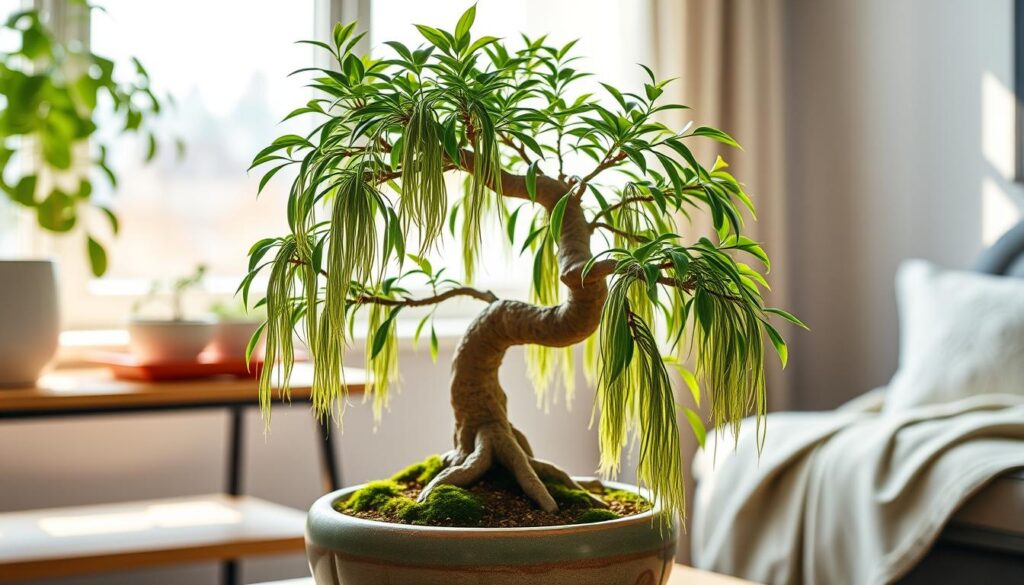
Stick to a regular care plan to make sure your bonsai does well indoors. It will add beauty and calm to your home.
“Bonsai is an art form that involves the cultivation of small trees in containers. It requires patience, precision, and a deep appreciation for the natural world.”
Watering Techniques for Ponytail Bonsai
Watering your ponytail bonsai right is key to its health and life span. These small trees need a regular watering plan that fits their special needs. Knowing the best ways to water will keep your bonsai happy and hydrated, making your home look more natural and elegant.
Proper Watering Schedule
Ponytail bonsai need water every two to three days indoors. Make sure to soak the soil until water drains from the pot’s holes. You can also use ice cubes on the soil to slowly water the roots. Never let your bonsai dry out completely, as it can harm the plant.
Water Quality Requirements
For your bonsai’s care, use purified or distilled water if you can. Tap water has minerals and salts that can hurt the plant over time. If you only have tap water, let it sit for 24 hours to remove chlorine before watering.
Common Watering Mistakes
- Overwatering: Too much water can cause root rot and harm the plant. Let the soil dry a bit between waterings.
- Underwatering: If the soil dries out too much, leaves will wilt and the plant gets stressed.
- Inconsistent watering: Switching between too much and too little water confuses the plant and slows its growth.
Stick to a regular watering schedule, use good water, and avoid common mistakes. This will help your ponytail bonsai grow well and keep its unique look.
Soil and Fertilization Requirements
For your ponytail bonsai, the right soil and fertilizer are key. They help keep your bonsai healthy and long-lived. Unlike regular potting soil, bonsai trees need a mix that drains well and is rich in nutrients.
Choose a high-quality bonsai soil mix. It should have akadama, pumice, and organic matter. This mix prevents the soil from getting too dense. It also makes sure the roots get the right amount of water and nutrients.
Fertilizing is vital for your ponytail bonsai‘s growth. Use water-soluble or time-released fertilizers as directed. For older bonsais, slow-releasing organic fertilizers are best. They give a steady flow of nutrients all season long.
| Fertilizer Type | Frequency | Dilution |
|---|---|---|
| Water-soluble | Monthly during growing season | 1/2 strength |
| Slow-release Organic | Annually or biannually | Full strength |
By managing your ponytail bonsai‘s soil and fertilization, you promote healthy growth. This leads to beautiful hair sculpting and topiary hair. Your indoor ponytail bonsai will flourish for many years.
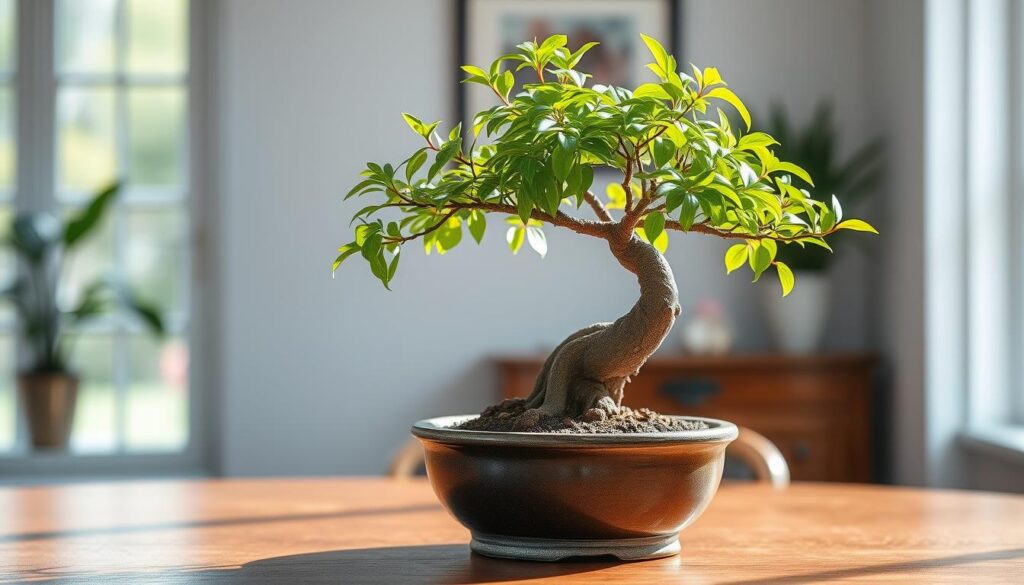
Pruning and Shaping Methods
Maintaining a ponytail bonsai small and shaped right needs regular pruning and careful shaping. These creative coiffure steps might look hard, but they’re key for the plant’s health and looks.
Basic Trimming Techniques
Trimming the bonsai often keeps its small size. For the best results, check out books or guides for hair shaping tips. Pruning regularly keeps the shape right and encourages healthy growth. Growers use special pruning to make the plant grow new shoots and leaves, creating more foliage caps.
Artistic Shaping Guidelines
The art of ponytail bonsai shaping lets you make unique and beautiful pieces. Skilled bonsai artists use wiring and growth manipulation to create detailed, sculptural forms. These can look like natural scenes or even people. But, remember, ponytail bonsai don’t need as much training as some other types and can’t be wired well.
| Pruning Technique | Benefits | Considerations |
|---|---|---|
| Regular Trimming | Maintains miniature size and shape | Refer to guides for proper techniques |
| Shaping and Wiring | Allows for artistic, sculptural forms | Ponytail bonsai do not require extensive wiring |
| Pup Removal | Encourages single-headed growth | Ponytail palms can be propagated from pups |
Learning to prune and shape ponytail bonsai lets fans make unique indoor displays. These displays show off the ancient art of bonsai in a modern, stylish way.
“The true essence of bonsai lies in the harmony between nature and the artist’s vision. Through careful pruning and shaping, we can unveil the inherent beauty of these miniature wonders.”
Growth Patterns and Development Stages
Ponytail bonsai growth patterns are truly mesmerizing. These indoor trees move gracefully and style beautifully. They adapt well to indoor spaces, taking weeks to adjust fully.
With proper care, these bonsai can live for years, growing and changing. Their slow growth allows for detailed shaping. This turns them into stunning botanical hairdressing pieces.
Their bulbous base and long leaves make them visually stunning. This enhances any indoor area. Exploring their growth is fascinating, showing their resilience and beauty.
By understanding their care, enthusiasts can help these ponytail bonsai reach their best. This showcases the versatility and beauty of these bonsai hairstyles.
“The ponytail bonsai is a true testament to the art of botanical hairdressing, where nature and creativity intertwine to create truly breathtaking displays of living sculpture.”

| Bonsai Palm Species | Distinctive Features | Growing Conditions |
|---|---|---|
| Ponytail Palm (Beaucarnea recurvata) | Bulbous base for water storage, long arching leaves | Well-draining soil, moderate sunlight, infrequent watering |
| Sago Palm (Cycas revoluta) | Rugged and textured trunk, circular frond growth | Bright indirect sunlight, protection from frost and extreme temperatures |
These ponytail bonsai and other bonsai palm species amaze enthusiasts. The art of botanical hairdressing grows, showing the beauty of these bonsai hairstyles.
Common Health Issues and Solutions
Ponytail bonsai trees are a joy to have, but they can get sick. It’s important to check them often for pests or diseases. A quick spray of water can keep your ponytail bonsai healthy and strong.
Pest Management
Ponytail bonsai trees can get pests like mealybugs and spider mites. If you see any pests, treat them fast with neem oil or insecticidal soap. Keeping your bonsai clean and watching it closely can stop pests from taking over.
Disease Prevention
Good care is key to keeping your ponytail bonsai healthy. Too much water can cause root rot, while too little can make leaves wilt. Make sure your bonsai gets the right amount of water and has good soil to drain excess water.
By being careful and quick to solve problems, you can keep your ponytail bonsai happy and healthy for many years.
Repotting Guidelines and Timeline
Keeping your ponytail bonsai healthy means repotting it sometimes. This refreshes the soil and helps the roots grow. You should repot every four to five years, or when the roots fill the pot.
The best time to repot is in late spring or early summer. This is when the plant is growing fast. Wait at least a year after getting a new bonsai before repotting. This lets it settle in its new home.
Use a special bonsai soil mix when repotting. It’s made for hair sculpting plants like your bonsai hairstyles. This mix helps with air and water, keeping your bonsai healthy.
“Proper repotting is key to the long-term health and vibrancy of your ponytail bonsai. By following these guidelines, you can ensure your ponytail bonsai continues to thrive for years to come.”
| Ponytail Bonsai Repotting Statistics | Value |
|---|---|
| Recommended Repotting Frequency | Every 4-5 years |
| Ideal Repotting Season | Late Spring / Early Summer |
| Minimum Wait Time After Receiving New Bonsai | 1 Growing Season |
| Recommended Soil Type | Well-Draining Bonsai Soil |
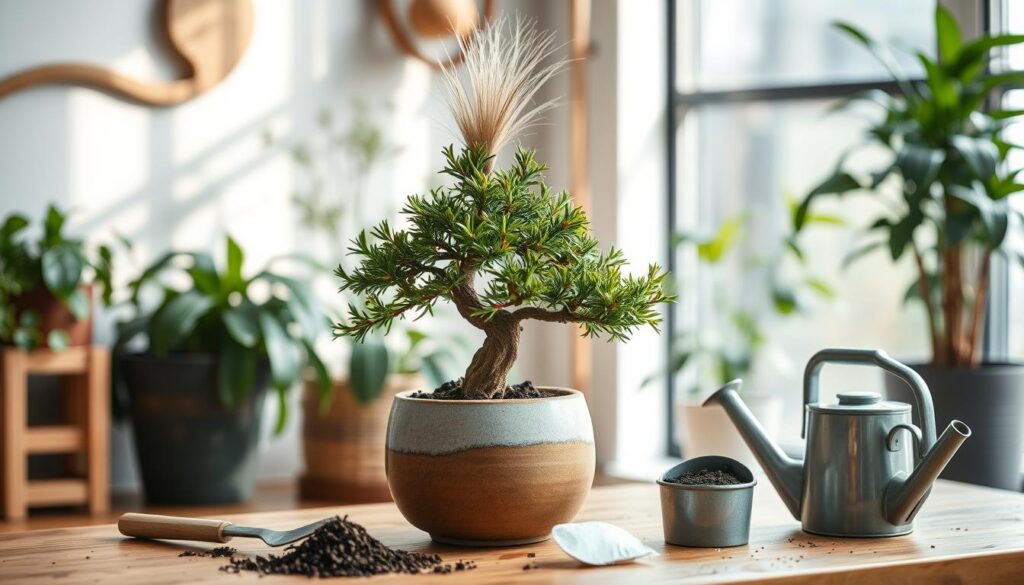
Shipping and Handling Information
We make sure your ponytail bonsai gets to you in top shape. These special, hair-shaping plants are packed with care and shipped right to your door.
Packaging Methods
Your bonsai tree is shipped with plenty of water and wrapped up tight. It’s covered in plastic to keep it moist and prevent spills. Then, it’s placed in strong, double-walled boxes for a safe trip.
Delivery Options and Timing
- FedEx Ground (free for orders $49+)
- FedEx Express Saver
- FedEx Standard Overnight
How fast you get your bonsai depends on where you are. It’s as quick as 1 business day for those on the West Coast. For everyone else, it’s 4-6 business days.
“The attention to detail in packaging and shipping ensures my ponytail bonsai arrived in perfect condition. I’m thrilled with the quality and care put into every aspect of my purchase.”
We’re all about doing things right. So, you can count on your ponytail bonsai arriving safely and on time. This means you can start your hair shaping and creative coiffure journey without delay.
Customer Satisfaction Guarantee
At Bonsai Tree Care, we’re proud of our ponytail bonsai trees and our skilled botanical hairdressers. That’s why we offer a 30-day satisfaction guarantee. If you’re not happy with your bonsai or our service, just let us know within 30 days. We’ll do our best to make it right.
Our ponytail bonsai trees are grown in top-notch greenhouses. We control the conditions to keep them healthy and vibrant. We’re all about quality and giving you a great experience from start to finish.
If you have questions or concerns, please contact our team. We’re here to help and make sure you’re completely satisfied with your new bonsai.
